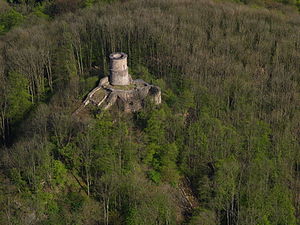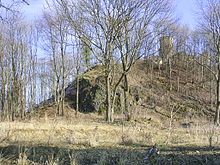Rennberg Castle
| Rennberg Castle | ||
|---|---|---|
|
Rennberg castle ruins |
||
| Creation time : | before 1250 | |
| Castle type : | Höhenburg, summit location | |
| Conservation status: | ruin | |
| Standing position : | Ministeriale | |
| Construction: | basalt | |
| Place: | Linz on the Rhine | |
| Geographical location | 50 ° 35 '35.5 " N , 7 ° 18' 50" E | |
| Height: | 349.7 m above sea level NHN | |
|
|
||
The Castle Mountain race was the headquarters of a Rhenish noble ruling families BadS that in 1217 with Konrad von race Mountain (1217-1224) and his sons as witnesses in a document of Cologne Archbishop Engelbert I was called for the first time. In 1585 the summit castle was already described as derelict. The castle ruins are located above the city of Linz am Rhein in the Neuwied district in Rhineland-Palatinate .
location
The castle ruins are located on the summit of a 349.7 m above sea level. NHN high basalt dome about three and a half kilometers northeast of the historic city center of Linz on the Rhine and two kilometers west of Notscheid (local community Sankt Katharinen ). The hilltop rises between the valleys of the Losbach in the north and the Rennenberger Bach in the south. It was also often referred to as "Rennenberg" or "Renneberg", but is not named as an independent mountain on topographic maps . About 100 meters to the north-west, below the ruins, is the residential area Alt Rennenberg I, which has been uninhabited since the late 1970s . It consists of one building and possibly goes back to the Rennberg farm mentioned at the beginning of the 19th century .
history
In several recognized reference works, Die Kunstdenkmäler der Rheinprovinz (1940), Hellmuth Gensicke : Landesgeschichte des Westerwaldes (1953/1999), Dehio : Rheinland-Pfalz, Saarland (1985), the first half of the 13th century is given as the period of origin. Local historians of the homeland assume a much earlier origin (7th or 8th century), but this cannot be proven otherwise.
In the middle of the 13th century the castle belonged to the fiefdom of Countess Mechthild von Sayn (1203–1285), which came from her maternal inheritance. In 1250 Mechthild signed a contract with the Cologne elector Konrad von Hochstaden (1205–1261), according to which the race mountain castle and the rest of its property would fall to the archbishopric of Cologne after her death . Since 1321 at the latest, Rennenberg Castle was a feudal castle in Cologne .
The truce belonging to the castle was insignificant. In the first half of the 15th century, the Rennenberger property under Rorich III. von Rennenberg (1403–1444) in addition to the courtyards of Linz , Ockenfels , Hallerbach and Hüngsberg (both now districts of Windhagen ) also some free float in the Westerwald , Maifeld , Eifel and Hunsrück .
In 1532 Philipp von Lalaing (1510–1555) inherited the race mountain castle. In 1585 the castle itself was described as dilapidated.
In 1765 the castle complex and the property belonging to it came into the ownership of the princes of Salm-Kyrburg . In connection with the construction of the Rennenberg Castle (1846; located about two kilometers southwest in the Rennenberger Bachtal) by Prince Friedrich IV von Salm-Kyrburg , the partly dilapidated keep was raised again. In 1979, the castle ruins were leased to a local association that tried to preserve and restore the ruins. The castle ruins, the surrounding area and the associated hunting rights have been owned by the Wirtgen family (mechanical engineering company Wirtgen in Windhagen ) since 2005 . No restoration work has taken place since 2007.
investment
The castle was probably built in two phases. The main castle was built around 1250 ; the round keep , made of basalt rubble , was probably built in the 14th century. The lower part of the keep, which is visible today, dates from this period, the upper, narrower part was added in the 19th century.
Originally the main tower on the east side of the castle hill was about 10 m high, it has a diameter of 2.50 m in the clear and a wall thickness of 1.70 m at the base. Today it is about 7 m high. The curtain wall , which has been partially preserved, has a narrow kennel on the eastern side of the attack . Further to the east, at a distance of about 50 m from the main castle, there was a bailey wall that approaches the main castle again in the south. On the south corner there are up to 4.20 m high wall remains of a 30 m long and 15 m wide house with walls up to 1.20 m thick. On the north side, the castle complex was secured by a neck ditch up to 10 m deep . To the south of the keep are the remains of buildings, further east the remains of the outer bailey .
Web links
- Entry on Raceberg Castle in the scientific database " EBIDAT " of the European Castle Institute
- Homepage of the Burg Rennenberg eV association
Individual evidence
- ↑ Information according to the digital topographic map 1: 5,000 (DTK5)
- ^ The government district of Coblenz according to its location, limitation, size, population and division ..., Coblenz: Pauli, 1817; P. 59 ( online )
- ^ A b c d e Heinrich Neu, Hans Weigert: Die Kunstdenkmäler des Kreis Neuwied (Die Kunstdenkmäler der Rheinprovinz, Volume 16, Section II), Düsseldorf, Schwann, 1940, page 343 ff
- ↑ a b c Hellmuth Gensicke : Landesgeschichte des Westerwaldes . 3. Edition. Historical Commission for Nassau, Wiesbaden 1999, pp. 201, 202, 320; ISBN 3-922244-80-7
- ^ Georg Dehio: Rhineland-Palatinate, Saarland. Deutscher Kunstverlag, Munich 1984, ISBN 3-422-00382-7 ( Handbuch der Deutschen Kunstdenkmäler ) p. 857
- ^ Rhein-Zeitung: A stately castle in the middle of the forest , July 26, 2007 ( Online , PDF)
- ↑ Thomas Bohn: Countess Mechthild von Sayn (1200 / 03-1285): a study on Rhenish history and culture ; Böhlau Verlag Cologne Weimar, 2002, p. 257; ISBN 3-412-10901-0 ( online )
- ↑ a b Entry by Jens Friedhoff on Raceberg Castle in the scientific database " EBIDAT " of the European Castle Institute, accessed on August 31, 2016.
- ^ Rhein-Zeitung: Association reconstructs castle , September 29, 2007 ( Online , PDF)





